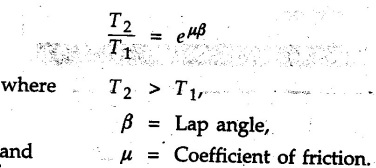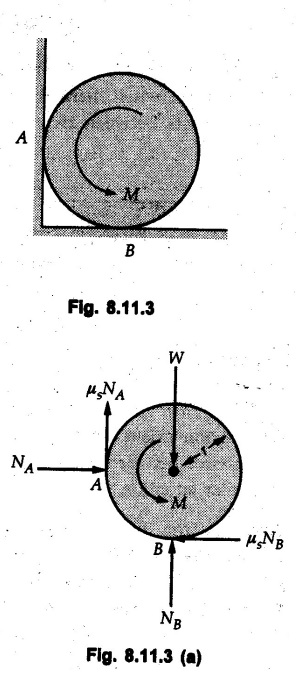Engineering Mechanics: Unit IV: Friction
Two Marks Questions with Answers
Friction | Engineering Mechanics
Two Marks Questions with Answers: Friction - Engineering Mechanics
Two Marks Questions with Answers Q.1 List out the different types of friction. What is coefficient of static friction ? Ans.: There are two types of friction: i) Dry friction or Coulomb friction ii) Fluid friction Q.2 Define coefficient of static friction. Ans.: Coefficient of static friction is defined as the ratio of frictional force at impending motion to the normal reaction on the body. Q.3 State the laws of dry friction. Ans.: The laws of dry friction are as follows: i) The force of friction opposes tendency for relative sliding motion or actual relative sliding motion of one contacting surface with respect to another and acts tangential to the surfaces. ii) The maximum value of frictional force is proportional to the normal reaction. iii) When there is relative motion between the two surfaces, the frictional force decreases and becomes constant. iv) Frictional force is independent of the surface area in contact. v) Frictional force depends only on the nature and material of the two surfaces in contact. Q.4 Why is static coefficient of friction always greater than kinetic coefficient of friction? Ans.: When there is relative motion between two surfaces in contact, there is less interpenetration between the surface irregularities due to which coefficient of static friction is always less than coefficient of kinetic friction. Q.5 Define limiting friction. Ans.: The maximum force of friction when motion impends is known as limiting friction. Q.6 Define angle of repose. Ans.: Angle of repose is the angle of an inclined plane at which motion impends for an object kept on it. Q.7 Define angle of friction. Ans.: The angle made by resultant of frictional force and normal reaction with the direction of normal reaction is known as angle of friction. Q.8 State the equation relating tensions in a belt on two sides of a pulley. Ans.: Q.9 When do we say that the motion of a body is impending ? Ans.: We say that motion is impending when the frictional force acting on it becomes maximum and the body is just about to move. Q.10 Distinguish between dry and fluid friction. OR What is dry friction? Ans.: Dry friction exists between two solid surface in contact when there is tendency for relative motion between them whereas fluid friction exists between two layers of fluid for a similar situation. Q.11 What is the force F required to just initiate the block shown in Fig. 8.11.1 to slide if the coefficient of friction between the surfaces in contact is 0.4 ? Ans.: To initiate the block the force F must be greater then 400 N. (F ≥ 400 N) Q.12. A uniform ladder of weight 'W' leans against a vertical wall. Assuming the contact surfaces as rough, draw the free body diagram of the ladder with necessary assumptions. Ans.: Q.13 The cylinder shown in Fig. 8.11.3 is of weight W and radius r and the coefficient of static friction μs is the same at A and B. If the cylinder is in equilibrium, draw the free body diagram of the cylinder. Ans.: FBD of cylinder is shown in Fig. 8.11.3 (a). Q.14 Define rolling resistance. Ans.: Rolling resistance or rolling friction is the force resisting the tion when a body rolls on a surface. It is caused by non-elastic effects.




Engineering Mechanics: Unit IV: Friction : Tag: : Friction | Engineering Mechanics - Two Marks Questions with Answers
Related Topics
Related Subjects
Engineering Mechanics
ME3351 3rd semester civil, Mechanical Dept | 2021 Regulation | 3rd Semester Mechanical Dept 2021 Regulation
